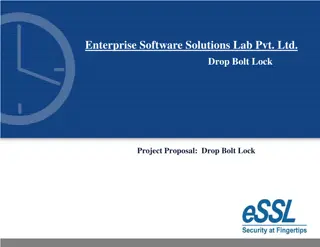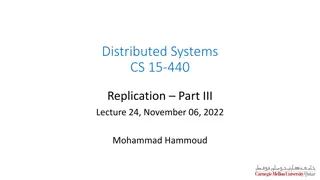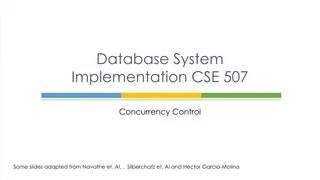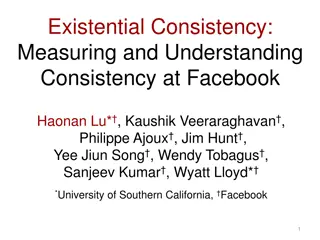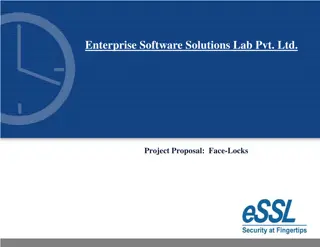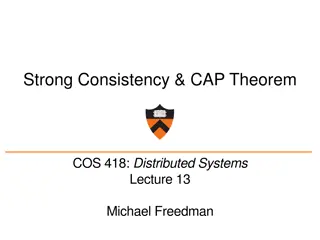
Transaction Atomicity, Consistency, and ACID Properties
Delve into the essential concepts of transaction management, including atomicity, consistency, and the ACID properties. Explore how transactions ensure data integrity and system reliability.
Download Presentation

Please find below an Image/Link to download the presentation.
The content on the website is provided AS IS for your information and personal use only. It may not be sold, licensed, or shared on other websites without obtaining consent from the author. If you encounter any issues during the download, it is possible that the publisher has removed the file from their server.
You are allowed to download the files provided on this website for personal or commercial use, subject to the condition that they are used lawfully. All files are the property of their respective owners.
The content on the website is provided AS IS for your information and personal use only. It may not be sold, licensed, or shared on other websites without obtaining consent from the author.
E N D
Presentation Transcript
Lock Granularity and Consistency Levels (Lecture 13, cs262a) Ion Stoica, UC Berkeley October 10, 2016
Transaction Definition A sequence of one or more operations on one or more databases, which reflects a single real-world transition
Example: Transaction BEGIN; --BEGIN TRANSACTION UPDATE accounts SET balance = balance - 100.00 WHERE name = 'Alice'; UPDATE branches SET balance = balance - 100.00 WHERE name = (SELECT branch_name FROM accounts WHERE name = 'Alice'); UPDATE accounts SET balance = balance + 100.00 WHERE name = 'Bob'; UPDATE branches SET balance = balance + 100.00 WHERE name = (SELECT branch_name FROM accounts WHERE name = 'Bob'); COMMIT; --COMMIT WORK Transfer $100 from Alice s account to Bob s account
Why it is Hard? Failures: might leave state inconsistent or cause updates to be lost Concurrency: might leave state inconsistent or cause updates to be lost
The ACID properties of Transactions Atomicity: all actions in the transaction happen, or none happen Consistency: if each transaction is consistent, and the database starts consistent, it ends up consistent, e.g., Balance cannot be negative Cannot reschedule meeting on February 30 Isolation: execution of one transaction is isolated from others Durability: if a transaction commits, its effects persist
Atomicity A transaction might commit after completing all its operations, or it could abort (or be aborted) after executing some operations Atomic transactions: a user can think of a transaction as always either executing all its operations, or not executing any operations at all Database/storage system logs all actions so that it can undo the actions of aborted transactions
Consistency Data follows integrity constraints (ICs) If database/storage system is consistent before transaction, it will remain so after transaction System checks ICs and if they fail, the transaction rolls back (i.e., is aborted) A database enforces some ICs, depending on the ICs declared when the data has been created Beyond this, database does not understand the semantics of the data (e.g., it does not understand how the interest on a bank account is computed)
Isolation Each transaction executes as if it was running by itself Concurrency is achieved by database/storage, which interleaves operations (reads/writes) of various transactions Techniques: Pessimistic: don t let problems arise in the first place Optimistic: assume conflicts are rare, deal with them after they happen
Durability Data should survive in the presence of System crash Disk crash need backups All committed updates and only those updates are reflected in the database Some care must be taken to handle the case of a crash occurring during the recovery process!
Concurrency When operations of concurrent threads are interleaved, the effect on shared state can be unexpected Well known issue in operating systems, thread programming Critical section in OSes Java use of synchronized keyword
Transaction Scheduling Why not run only one transaction at a time? Answer: low system utilization Two transactions cannot run simultaneously even if they access different data Goal of transaction scheduling: Maximize system utilization, i.e., concurrency Interleave operations from different transactions Preserve transaction semantics Logically all operations in a transaction are executed atomically Intermediate state of a transaction is not visible to other transactions
Goals of Transaction Scheduling Maximize system utilization, i.e., concurrency Interleave operations from different transactions Preserve transaction semantics Semantically equivalent to a serial schedule, i.e., one transaction runs at a time T2: T2: R, W, R, R, W T1: T1: R, W, R, W Serial schedule (T1, then T2): Serial schedule (T2, then T1): R, W, R, W, R, W, R, R, W R, W, R, R, W, R, W, R, W
Two Key Questions 1) Is a given schedule equivalent to a serial execution of transactions? R, R, W, W, R, R, R, W, W Schedule: ? ? Serial schedule (T1, then T2): Serial schedule (T2, then T1): R, W, R, W, R, W, R, R, W : R, W, R, R, W, R, W, R, W 2) How do you come up with a schedule equivalent to a serial schedule?
Transaction Scheduling Serial schedule: : A schedule that does not interleave the operations of different transactions Transactions run serially (one at a time) Equivalent schedules: For any storage/database state, the effect (on storage/database) and output of executing the first schedule is identical to the effect of executing the second schedule Serializable schedule: A schedule that is equivalent to some serial execution of the transactions Intuitively: with a serializable schedule you only see things that could happen in situations where you were running transactions one-at-a-time
Anomalies with Interleaved Execution May violate transaction semantics, e.g., some data read by the transaction changes before committing Inconsistent database state, e.g., some updates are lost Anomalies always involves a write ; Why?
Anomalies with Interleaved Execution Read-Write conflict (Unrepeatable reads) T1:R(A), R(A),W(A) T2: R(A),W(A) Violates transaction semantics Example: Mary and John want to buy a TV set on Amazon but there is only one left in stock (T1) John logs first, but waits (T2) Mary logs second and buys the TV set right away (T1) John decides to buy, but it is too late
Anomalies with Interleaved Execution Write-read conflict (reading uncommitted data) T1:R(A),W(A), W(A) T2: R(A), Example: (T1) A user updates value of A in two steps (T2) Another user reads the intermediate value of A, which can be inconsistent Violates transaction semantics since T2 is not supposed to see intermediate state of T1
Anomalies with Interleaved Execution Write-write conflict (overwriting uncommitted data) T1:W(A), W(B) T2: W(A),W(B) Get T1 s update of B and T2 s update of A Violates transaction serializability If transactions were serial, you d get either: T1 s updates of A and B T2 s updates of A and B
Conflict Serializable Schedules Two operations conflict if they Belong to different transactions Are on the same data At least one of them is a write Two schedules are conflict equivalent iff: Involve same operations of same transactions Every pair of conflicting operations is ordered the same way Schedule S is conflict serializable if S is conflict equivalent to some serial schedule
Conflict Equivalence Intuition If you can transform an interleaved schedule by swapping consecutive non-conflicting operations of different transactions into a serial schedule, then the original schedule is conflict conflict serializable serializable, e.g., T1:R(A),W(A), R(B),W(B) T2: R(A),W(A), R(B),W(B) T1:R(A),W(A), R(B), W(B) T2: R(A), W(A), R(B),W(B) T1:R(A),W(A),R(B), W(B) T2: R(A),W(A), R(B),W(B)
Conflict Equivalence Intuition If you can transform an interleaved schedule by swapping consecutive non-conflicting operations of different transactions into a serial schedule, then the original schedule is conflict conflict serializable serializable, e.g., T1:R(A),W(A),R(B), W(B) T2: R(A),W(A), R(B),W(B) T1:R(A),W(A),R(B), W(B) T2: R(A), W(A),R(B),W(B) T1:R(A),W(A),R(B),W(B) T2: R(A), W(A),R(B),W(B)
Conflict Equivalence Intuition If you can transform an interleaved schedule by swapping consecutive non-conflicting operations of different transactions into a serial schedule, then the original schedule is conflict conflict serializable serializable, e.g., T1:R(A), W(A) T2: R(A),W(A), Is this schedule serializable?
Dependency Graph Dependency graph: Dependency graph: Transactions represented as nodes Edge from Ti to Tj: an operation of Ti conflicts with an operation of Tj Ti appears earlier than Tj in the schedule Theorem: Theorem: Schedule is conflict serializable if and only if its dependency graph is acyclic
Example Conflict serializable schedule: T1:R(A),W(A), R(B),W(B) T2: R(A),W(A), R(B),W(B) B A Dependency graph T1 T2 No cycle!
Example Conflict that is not serializable: T1:R(A),W(A), R(B),W(B) T2: R(A),W(A),R(B),W(B) A Dependency graph T1 T2 B Cycle: The output of T1 depends on T2, and vice-versa
Notes on Conflict Serializability Conflict Serializability doesn t allow all schedules that you would consider correct This is because it is strictly syntactic - it doesn t consider the meanings of the operations or the data Many times, Conflict Serializability is what gets used, because it can be done efficiently See isolation degrees/levels next Two-phase locking (2PL) is how we implement it
Srializability Conflict Serializability Following schedule is not not conflict serializable Dependency graph A A A T1:R(A), W(A), T2: W(A), T3: WA However, the schedule is serializable since its output is equivalent with the following serial schedule T1:R(A),W(A), T2: W(A), T3: WA T1 T2 A T3 Note: deciding whether a schedule is serializable (not conflict- serializable) is NP-complete
Locks Locks to control access to data Two types of locks: shared (S) lock: multiple concurrent transactions allowed to operate on data exclusive (X) lock: only one transaction can operate on data at a time Lock Compatibility Matrix Held\Request S S X X Block Block Yes Block
Two-Phase Locking (2PL) 1) Each transaction must obtain: S (shared) or X (exclusive) lock on data before reading, X (exclusive) lock on data before writing 2) A transaction can not request additional locks once it releases any locks Thus, each transaction has a growing phase followed by a shrinking phase 4 # Locks Held Lock Point! Growing Phase Shrinking Phase 3 2 1 0 1 3 5 7 9 11 13 15 17 19 Time
Two-Phase Locking (2PL) 2PL guarantees conflict serializability Doesn t allow dependency cycles. Why? Answer: a dependency cycle leads to deadlock Assume there is a cycle between Ti and Tj Edge from Ti to Tj: Ti acquires lock first and Tj needs to wait Edge from Tj to Ti: Tj acquires lock first and Ti needs to wait Thus, both Ti and Tj wait for each other Since with 2PL neither Ti nor Tj release locks before acquiring all locks they need deadlock Schedule of conflicting transactions is conflict equivalent to a serial schedule ordered by lock point
Example T1 transfers $50 from account A to account B T1:Read(A),A:=A-50,Write(A),Read(B),B:=B+50,Write(B) T2 outputs the total of accounts A and B T2:Read(A),Read(B),PRINT(A+B) Initially, A = $1000 and B = $2000 What are the possible output values?
Is this a 2PL Schedule? 1 2 3 4 Lock_X(A) <granted> Read(A) A: = A-50 Write(A) Lock_S(A) 5 6 7 8 9 Unlock(A) <granted> Read(A) Unlock(A) Lock_S(B) <granted> Lock_X(B) 10 11 12 13 14 15 16 Read(B) Unlock(B) PRINT(A+B) <granted> Read(B) B := B +50 Write(B) Unlock(B) No, and it is not serializable
Is this a 2PL Schedule? 1 2 3 4 Lock_X(A) <granted> Read(A) A: = A-50 Write(A) Lock_S(A) 5 6 7 8 9 Lock_X(B) <granted> Unlock(A) <granted> Read(A) Lock_S(B) Read(B) B := B +50 Write(B) Unlock(B) 10 11 12 13 14 15 16 <granted> Unlock(A) Read(B) Unlock(B) PRINT(A+B) Yes, so it is serializable
Cascading Aborts Example: T1 aborts Note: this is a 2PL schedule T1:R(A),W(A), R(B),W(B), Abort T2: R(A),W(A) Rollback of T1 requires rollback of T2, since T2 reads a value written by T1 Solution: Strict Two Strict Two- -phase Locking (Strict 2PL) phase Locking (Strict 2PL): same as 2PL except All locks held by a transaction are released only when the transaction completes
Strict 2PL (contd) All locks held by a transaction are released only when the transaction completes In effect, shrinking phase is delayed until: a) Transaction has committed (commit log record on disk), or b) Decision has been made to abort the transaction (then locks can be released after rollback).
Is this a Strict 2PL schedule? 1 2 3 4 Lock_X(A) <granted> Read(A) A: = A-50 Write(A) Lock_S(A) 5 6 7 8 9 Lock_X(B) <granted> Unlock(A) <granted> Read(A) Lock_S(B) Read(B) B := B +50 Write(B) Unlock(B) 10 11 12 13 14 15 16 <granted> Unlock(A) Read(B) Unlock(B) PRINT(A+B) No: Cascading Abort Possible
Is this a Strict 2PL schedule? 1 2 3 4 Lock_X(A) <granted> Read(A) A: = A-50 Write(A) Lock_S(A) 5 6 7 8 9 Lock_X(B) <granted> Read(B) B := B +50 Write(B) Unlock(A) Unlock(B) 10 11 12 13 14 15 16 <granted> Read(A) Lock_S(B) <granted> Read(B) PRINT(A+B) Unlock(A) Unlock(B)
Granularity What is a data item (on which a lock is obtained)? Most times, in most modern systems: item is one tuple in a table Sometimes (especially in early 1970s): item is a page (with several tuples) Sometimes: item is a whole table
Granularity trade-offs Larger granularity: fewer locks held, so less overhead; but less concurrency possible false conflicts when txns deal with different parts of the same item Smaller fine granularity: more locks held, so more overhead; but more concurrency is possible System usually gets fine grain locks until there are too many of them; then it replaces them with larger granularity locks
Multigranular locking Care needed to manage conflicts properly among items of varying granularity Note: conflicts only detectable among locks on a given item name System gets intention mode locks on larger granules before getting actual S/X locks on smaller granules Conflict rules arranged so that activities that do not commute must get conflicting locks on some item
Lock Mode Conflicts Held\Request IS IS IX S SIX X IX Yes Yes Block Block Block S Yes Block Yes Block Block SIX Yes Block Block Block Block X Block Block Block Block Block Yes Yes Yes Yes Block
Lock manager internals Hash table, keyed by hash of item name Each item has a mode and holder (set) Wait queue of requests All requests and locks in linked list from transaction information Transaction table To allow thread rescheduling when blocking is finished Deadlock detection Either cycle in waits-for graph, or just timeouts
Problems with serializability The performance reduction from isolation is high Transactions are often blocked because they want to read data that another transactions has changed For many applications, the accuracy of the data they read is not crucial e.g. overbooking a plane is ok in practice e.g. your banking decisions would not be very different if you saw yesterday s balance instead of the most up-to-date

